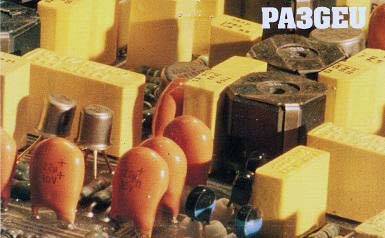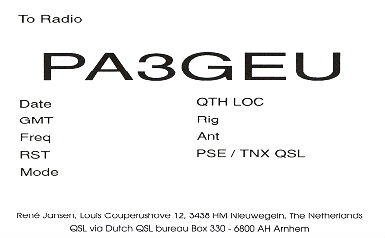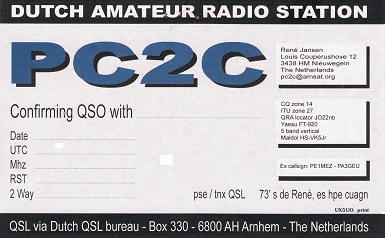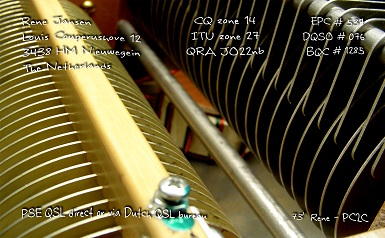I have always had a love of QSLs and QSLing. I enjoy the individual works of art adorned with QSO information and callsigns.
Paper QSLs are sent and received through the bureau, as well as direct. If you send me a QSL, you will get one in return, provided you follow these simple methods.
I prefer a paper QSL by Dutch QSL Bureau. If you sent me one, you get one in return by bureau.
Sending this way takes a long time but is very cheap and you must be a member of an association.
If you QSL direct, no problem, you receive direct.
As long as I don't have to send a huge amount of cards no SASEs or green stamps are required.
My logs are regularly uploaded to
LoTW
NOTE: I do not use the logs on eQSL.cc or QRZ.com on a regular basis. Please don't ask me.

My first QSL card.
A picture of a PCB which came out of the junk box. The card was printed by myself and used from 1987 until 1992.

QSL card V2.0
After I passed my morse code exam I got the callsign PA3GEU. Same card - different callsign. This design was used from 1992 until 2003.

What is on the back.
Both cards PE1MEZ as PA3GEU had the same backside (except for the callsign of course). The private address at the bottom of the card has changed over the years.

A new callsign - A new design.
In 2003 I got my callsign changed to PC2C and made a new card printed by UX5UO. This card has been used from 2003 until 2008.

This is my current QSL card.
It is a picture of the s-meter of my former Yaesu FT-2000. The card was printed by Max - ON5UR and I use this card up to now.

A quick look at the back.
The photo is of the inductor and capacitor of my Palstar tuner. The QSO data are no longer filled in by hand, but printed on a label.






